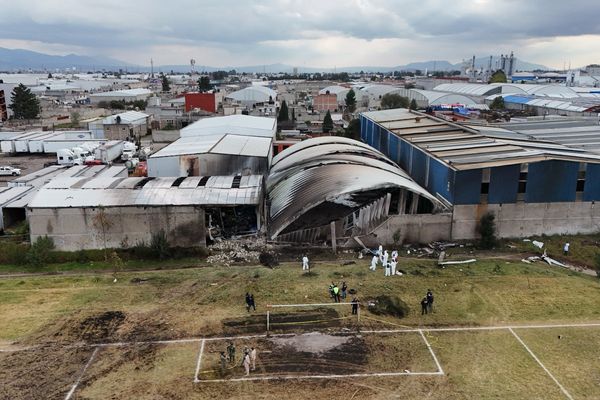
Once again, vulnerabilities of Sydney’s rail network have been exposed, bringing the city to a standstill. Unlike train systems in most global cities, almost all rail lines converge over a short stretch in the city’s west. Complicating the issue further is a reliance on hand-delivered paper communications between train staff.
At peak hour on Wednesday morning, buses were packed with frustrated commuters who normally rely on trains to get from Sydney’s north shore into the city.
“Nah, mate, I’m on a bloody bus,” a banker from Roseville wearing a three-piece suit said into his AirPods as he tried to explain why he was late for a meeting.
It was 18 hours after a live wire with enough voltage to instantly kill a human fell on the top of a train, trapping 300 passengers onboard and grinding all heavy rail lines – with the exception of the Eastern Suburbs and Illawarra line – to a halt, but train riders across the city had still been warned to avoid using the network. Some lines had resumed, with heavy delays, but where exactly they were running was unclear.
The banker from Roseville had checked the TripView and Google Maps apps but was unable to ascertain if trains were even running from Roseville station, a short stroll from his home. Instead, he walked roughly half an hour to an arterial road to catch a bus into the city. Bus after bus whooshed past, too full to pick up passengers.
“Sydney, it’s the best city in the world, until the trains cark it again,” he said.
While transport chiefs and the state premier, Chris Minns, swiftly apologised to commuters and promised a fare-free day next week, the pattern felt all too common.
An independent review into the incident and train unreliability more broadly will soon begin. However, experts, including former senior rail department leaders, say there is little that can be done to prevent city-wide outages from recurring.
‘Archaic’ communications
While technical issues are unavoidable on a rail network that hosts 400m trips each year, the latest outage has reignited the nagging question on the minds of millions of Sydneysiders: how can just one incident on one train at a station with multiple tracks bring down an entire city’s rail network?
Increasingly, another question is front of mind: how can communications from transport authorities be so poor when the worst does happen?
The answer to the first question is easier to comprehend, and dates back to plans made in the early 1900s – including a famous vision for new lines from Sydney Harbour Bridge engineer John Bradfield – about how to expand the rail network to cater to a growing Sydney.
Rather than a master plan for new lines independent of each other – as modern metro and underground systems were increasingly being built throughout the 20th century – the approach for Sydney was to take advantage of the huge capacity of the six tracks that comprise its main western railway between Central and Strathfield.
In cities such as London, commuters can avoid a bottleneck or outage on one line by switching to another to dodge a problem section of track. But almost all heavy rail services in Sydney’s suburban network – including trains to the Central Coast, Blue Mountains, city circle or airport – are routed to pass through the Central-Strathfield corridor.
“A lot of our lines are tangled with each other,” the Sydney Trains CEO, Matt Longland, said. “At this critical pinch point … one incident in a location like this can bring down a significant part of the network.”
In the case of Roseville station on the North Shore line, city-bound trains do not traverse the Central-Strathfield stretch before reaching the CBD, but services then continue on the same tracks to the western suburbs past Strathfield. Once any track is closed, the conga-line of trains using it must halt, and city-wide timetables go out the window.
Attempts have been made in recent years to detangle the train lines, and on Wednesday, Longland said “simplifying” the network would be examined as part of the review.
The Eastern Suburbs line, constructed in the 1970s, and new Metro lines are independent and weren’t harmed by Tuesday’s outage – the more complicated task is restructuring the network’s overall design to avoid a single point of failure.
Other issues are easier to address.
Communications to passengers on Tuesday evening were frenzied and inconsistent. A snap press conference was called for 4.30pm and commuters urged to “plan ahead” to make alternative travel plans home.
There were chaotic scenes at Sydney’s Central station as thousands of commuters heading home flooded platforms to board trains that were mostly not running. Departure information screens did not display up-to-date information and station staff gave conflicting messages about how commuters should get home.
Widely used travel apps which rely on government data were rendered useless as timetabled services were abandoned in favour of shuttle train services not reflected in apps. This, however, did not stop station staff relying on Google Maps and TripView to give travellers incorrect advice.
Minns has said that communications will be examined in the snap review of the incident.
“[Even] if there’s no information because the problem hasn’t been diagnosed yet, well that’s still information that would be valuable [for commuters] to have,” Minns said. “Even if it is inconvenient, even if it is sometimes embarrassing for the government, it’s still crucial for commuters to know.”
However, improving internal staff communications will also be essential.
Multiple rail sources speaking on the condition of anonymity have told Guardian Australia that in some parts of the network, information about disruptions is delivered to staff on trains by hand-written notes, including writing on carbon paper to replicate messages.
“Parts of the system remain very archaic, hand-delivering paper to drivers and guards,” one source said.
Another added: “This is a network that started in 1855 and many parts of the network operate under historic practices. It’s hard to update all at once when you’re dealing with thousands of kilometres of track.”
For now, before the review can be conducted and findings implemented, Sydneysiders should not be surprised by more city-wide train failures.
After months of industrial action-related outages, and with the memory of a horror run of similar rail outages in the weeks before the NSW Coalition lost the 2023 election and Labor formed government, Minns appears under no illusions about the importance of ensuring trains run smoothly.
“I stay up at nights worrying about this,” he said.







